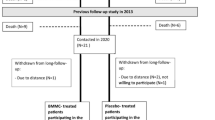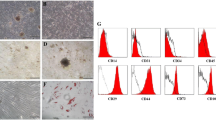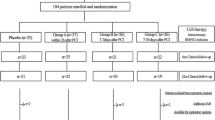Abstract
Incomplete revascularization is associated with worse long-term outcomes. Autologous bone marrow cells (BMC) have recently been tested in patients with severe coronary artery disease. We tested the hypothesis that intramyocardial injection of autologous BMC increases myocardial perfusion in patients undergoing incomplete coronary artery bypass grafting (CABG). Twenty-one patients (19 men), 59 ± 7 years old, with limiting angina and multivessel coronary artery disease (CAD), not amenable to complete CABG were enrolled. BMC were obtained prior to surgery, and the lymphomonocytic fraction separated by density gradient centrifugation. During surgery, 5 mL containing 2.1 ± 1.3 × 108 BMC (CD34+ = 0.8 ± 0.3%) were injected in the ischemic non-revascularized myocardium. Myocardial perfusion was assessed by magnetic resonance imaging (MRI) at baseline and 1 month after surgery. The increase in myocardial perfusion was compared between patients with <50% (group A, n = 11) with that of patients with >50% (group B, n = 10) of target vessels (stenosis ≥ 70%) successfully bypassed. Injected myocardial segments included the inferior (n = 12), anterior (n = 7), and lateral (n = 2) walls. The number of treated vessels (2.3 ± 0.8) was significantly smaller than the number of target vessels (4.2 ± 1.0; P < 0.0001). One month after surgery, cardiac MRI showed a similar reduction (%) in the ischemic score of patients in group A (72.5 ± 3.2), compared to patients in group B (78.1 ± 3.2; P = .80). Intramyocardial injection of autologous BMC may help increase myocardial perfusion in patients undergoing incomplete CABG, even in those with fewer target vessels successfully treated. This strategy may be an adjunctive therapy for patients suffering from a more advanced (diffuse) CAD not amenable for complete direct revascularization.



Similar content being viewed by others
References
Almeda, F. Q., & Snell, R. J. (2005). Coronary revascularization in multivessel disease. Which is better, stents or surgery? Postgraduate Medicine, 118, 11–17.
Caines, A. E., Massad, M. G., Kpodonu, J., Rebeiz, A. G., Evans, A., & Geha, A. S. (2004). Outcomes of coronary artery bypass grafting versus percutaneous coronary intervention and medical therapy for multivessel disease with and without left ventricular dysfunction. Cardiology, 101, 21–28.
Hueb, W., Soares, P. R., Gersh, B. J., et al. (2004). The medicine, angioplasty, or surgery study (MASS-II): a randomized, controlled clinical trial of three therapeutic strategies for multivessel coronary artery disease: one-year results. Journal of the American College of Cardiology, 43, 1743–1751.
Serruys, P. W., Ong, A. T., van Herwerden, L. A., et al. (2005). Five-year outcomes after coronary stenting versus bypass surgery for the treatment of multivessel disease: the final analysis of the Arterial Revascularization Therapies Study (ARTS) randomized trial. Journal of the American College of Cardiology, 46, 575–581.
Investigators, So S. (2002). Coronary artery bypass surgery versus percutaneous coronary intervention with stent implantation in patients with multivessel coronary artery disease (the Stent or Surgery trial): a randomised controlled trial. Lancet, 360, 965–970.
The Bypass Angioplasty Revascularization Investigation (BARI) Investigators. (1996). Comparison of coronary bypass surgery with angioplasty in patients with multivessel disease. The New England Journal of Medicine, 335, 217–225.
Zimarino, M., Calafiore, A. M., & De Caterina, R. (2005). Complete myocardial revascularization: between myth and reality. European Heart Journal, 26, 1824–1830.
Caputo, M., Reeves, B. C., Rajkaruna, C., Awair, H., & Angelini, G. D. (2005). Incomplete revascularization during OPCAB surgery is associated with reduced mid-term event-free survival. The Annals of Thoracic Surgery, 80, 2141–2147.
McLellan, C. S., Ghali, W. A., Labinaz, M., et al. (2005). Alberta Provincial Project for Outcomes Assessment in Coronary Heart Disease (APPROACH) Investigators. Association between completeness of percutaneous coronary revascularization and postprocedure outcomes. American Heart Journal, 150, 800–806.
Kozower, B. D., Moon, M. R., Barner, H. B., et al. (2005). Impact of complete revascularization on long-term survival after coronary artery bypass grafting in octogenarians. The Annals of Thoracic Surgery, 80, 112–116.
Kleisli, T., Cheng, W., Jacobs, M. J., et al. (2005). In the current era, complete revascularization improves survival after coronary artery bypass surgery. The Journal of Thoracic and Cardiovascular Surgery, 129, 1283–1291.
Luttun, A., Carmeliet, G., & Carmeliet, P. (2002). Vascular progenitors: from biology to treatment. Trends in Cardiovascular Medicine, 12, 88–96.
Takahashi, T., Kalka, C., Masuda, H., et al. (1999). Ischemia- and cytokine-induced mobilization of bone marrow-derived endothelial progenitor cells for neovascularization. Natural Medicines, 5, 434–438.
Orlic, D., Kajstura, J., Chimenti, S., et al. (2001). Mobilized bone marrow cells repair the infarcted heart, improving function and survival. Proceedings of the National Academy of Sciences of the United States of America, 98, 10344–10349.
Kocher, A. A., Schuster, M. D., Szabolcs, M. J., et al. (2001). Neovascularization of ischemic myocardium by human bone marrow-derived angioblasts prevents cardiomyocyte apoptosis, reduces remodeling and improves cardiac function. Natural Medicines, 7, 430–436.
Orlic, D., Kajstura, J., Chimenti, S., et al. (2001). Bone marrow cells regenerate infarcted myocardium. Nature, 410, 701–705.
Assmus, B., Schachinger, V., Teupe, C., et al. (2002). Transplantation of progenitor cells and regeneration enhancement in acute myocardial infarction (TOPCARE-AMI). Circulation, 106, 3009–3017.
Wollert, K. C., Meyer, G. P., Lotz, J., et al. (2004). Intracoronary autologous bone-marrow cell transfer after myocardial infarction: the BOOST randomised controlled clinical trial. Lancet, 364, 141–148.
Perin, E. C., Dohmann, H. F., Borojevic, R., et al. (2003). Transendocardial, autologous bone marrow cell transplantation for severe, chronic ischemic heart failure. Circulation, 107, 2294–2302.
Campeau, L. (1976). Grading of angina pectoris. Circulation, 54, 522–523.
Lunde, K., Solheim, S., Aakhus, S., et al. (2006). Intracoronary injection of mononuclear bone marrow cells in acute myocardial infarction. New England Journal of Medicine, 355, 1199–1209.
Yerebakan, C., Uğurlucan, M., Kaminski, A., Westphal, B., Liebold, A., & Steinhoff, G. (2009). Autologous stem cell therapy with surgical myocardial revascularization—The Rostock University experience. Anadolu Kardiyoloji Dergisi, 9, 457–464.
Mocini, D., Staibano, M., Mele, L., et al. (2006). Autologous bone marrow mononuclear cell transplantation in patients undergoing coronary artery bypass grafting. American Heart Journal, 151, 192–197.
Stamm, C., Westphal, B., Kleine, H. D., et al. (2003). Autologous bone marrow stem cell transplantation for myocardial regeneration. Lancet, 361, 45–46.
Zhao, Q., Sun, Y., Xia, L., Chen, A., & Wang, Z. (2008). Randomized study of mononuclear bone marrow cell transplantation in patients with coronary surgery. The Annals of Thoracic Surgery, 86, 1833–1840.
Gowdak, L. H., Schettert, I. T., Baptista, E., et al. (2008). Intramyocardial injection of autologous bone marrow cells as an adjunctive therapy to incomplete myocardial revascularization—safety issues. Clinics (Sao Paulo)., 63, 207–214.
Schächinger, V., Erbs, S., Elsässer, A., et al. (2006). Intracoronary bone marrow-derived progenitor cells in acute myocardial infarction. New England Journal of Medicine, 355, 1199–1209.
Eagle, K. A., Guyton, R. A., Davidoff, R., et al. ACC/AHA 2004 guideline update for coronary artery bypass graft surgery: a report of the American College of Cardiology/American Heart Association Task Force on Practice Guidelines (Committee to Update the 1999 Guidelines for Coronary Artery Bypass Graft Surgery). American College of Cardiology website. Available at http://www.acc.org/clinical/guidelines/cabg/cabg.pdf.
Gibbons RJ, RJ, Abrams J, Chatterjee K, et al. ACC/AHA 2002 guideline update for the management of patients with chronic stable angina: a report of the American College of Cardiology/American Heart Association Task Force on Practice Guidelines (Committee to Update the 1999 Guidelines for the Management of Patients with Chronic Stable Angina). 2002. Available at http://www.acc.org/clinical/guidelines/stable/stable.pdf.
Kalkman, E. A., Bilgin, Y. M., van Haren, P., et al. (1996). Determinants of coronary reserve in rats subjected to coronary artery ligation or aortic banding. Cardiovascular Research, 32, 1088–1095.
Shintani, S., Murohara, T., Ikeda, H., et al. (2001). Mobilization of endothelial progenitor cells in patients with acute myocardial infarction. Circulation, 103, 2776–2779.
Kalka, C., Masuda, H., Takahashi, T., et al. (2000). Transplantation of ex vivo expanded endothelial progenitor cells for therapeutic neovascularization. Proceedings of the National Academy of Sciences of the United States of America, 97, 3422–3427.
Rafii, S., & Lyden, D. (2003). Therapeutic stem and progenitor cell transplantation for organ vascularization and regeneration. Natural Medicines, 9, 702–712.
Li, T. S., Hamano, K., Hirata, K., Kobayashi, T., & Nishida, M. (2003). The safety and feasibility of the local implantation of autologous bone marrow cells for ischemic heart disease. Journal of Cardiac Surgery, 18(Suppl 2), S69–S75.
Carmeliet, P. (2003). Angiogenesis in health and disease. Natural Medicines, 9, 653–660.
de Oliveira, S. A., Gowdak, L. H., Buckberg, G., Krieger, J. E., & The RESTORE Group. (2006). Cell biology, MRI and geometry: insight into a microscopic/macroscopic marriage. Eur J Cardiothorac Surg, 29, S259–S265.
Ang, K. L., Chin, D., Leyva, F., et al. (2008). Randomized, controlled trial of intramuscular or intracoronary injection of autologous bone marrow cells into scarred myocardium during CABG versus CABG alone. Nature Clinical Practice. Cardiovascular Medicine, 5, 663–670.
Tura, B. R., Martino, H. F., Gowdak, L. H., et al. (2007). Multicenter randomized trial of cell therapy in cardiopathies—MiHeart Study. Trials, 8, 2.
Chung, S. Y., Lee, K. Y., Chun, E. J., et al. (2010). Comparison of stress perfusion MRI and SPECT for detection of myocardial ischemia in patients with angiographically proven three-vessel coronary artery disease. AJR. American Journal of Roentgenology, 195, 356–362.
Sousa Uva, M., Cavaco, S., Oliveira, A. G., et al. (2010). Early graft patency after off-pump and on-pump coronary bypass surgery: a prospective randomized study. Eur Heart J (in press).
Boeken, U., Feindt, P., Litmathe, J., & Gams, E. (2004). Comparison of complete and incomplete revascularization in CABG patients with severely impaired left ventricular function (LVF). Zeitschrift für Kardiologie, 93, 216–221.
Osswald, B. R., Tochtermann, U., Schweiger, P., Thomas, G., Vahl, C. F., & Hagl, S. (2001). Does the completeness of revascularization contribute to an improved early survival in patients up to 70 years of age? Thoracic and Cardiovascular Surgeon, 49, 373–377.
Scott, R., Blackstone, E. H., McCarthy, P. M., et al. (2000). Isolated bypass grafting of the left internal thoracic artery to the left anterior descending coronary artery: late consequences of incomplete revascularization. The Journal of Thoracic and Cardiovascular Surgery, 120, 173–184.
Acknowledgments
The authors would like to express their gratefulness to Teresa Cristina B. F. da Silva, RN, for her dedication to the care of patients; to Maria de Lourdes Junqueira, BS, for technical assistance; and to Meyrielli Alves Vieira, for secretarial assistance. This study was supported by grants from Fundação de Amparo à Pesquisa do Estado de São Paulo (FAPESP Grant 01/00009-0 to JEK), Conselho Nacional de Desenvolvimento Científico e Tecnológico (CNPq Grant 552320/2005/6 to LHWG, and 552324/2005-1 to JEK) and Fundação Zerbini.
Author information
Authors and Affiliations
Corresponding author
Rights and permissions
About this article
Cite this article
Gowdak, L.H.W., Schettert, I.T., Rochitte, C.E. et al. Early Increase in Myocardial Perfusion After Stem Cell Therapy in Patients Undergoing Incomplete Coronary Artery Bypass Surgery. J. of Cardiovasc. Trans. Res. 4, 106–113 (2011). https://doi.org/10.1007/s12265-010-9234-2
Received:
Accepted:
Published:
Issue Date:
DOI: https://doi.org/10.1007/s12265-010-9234-2




